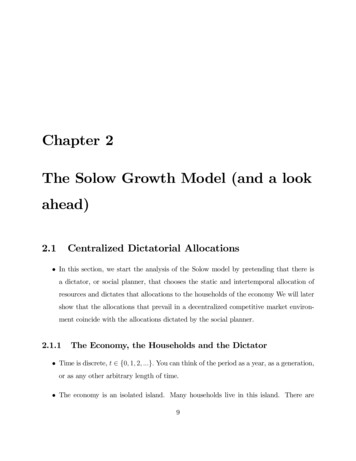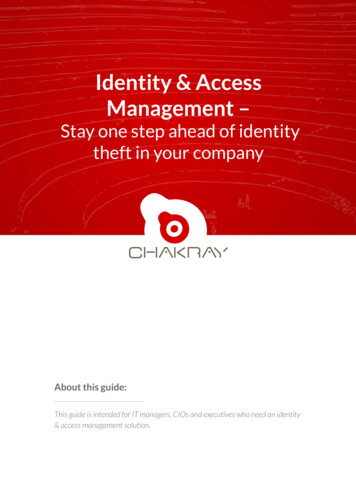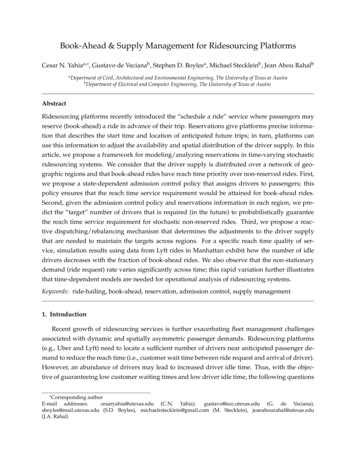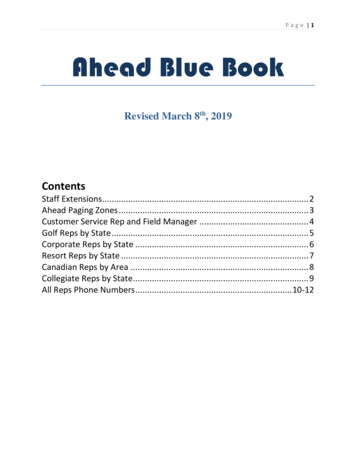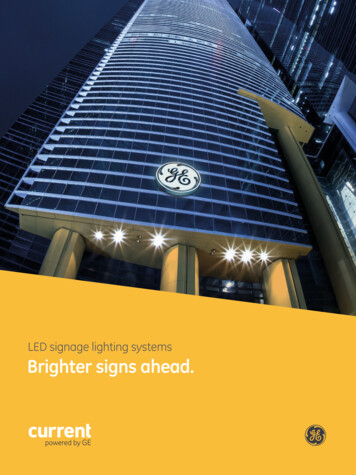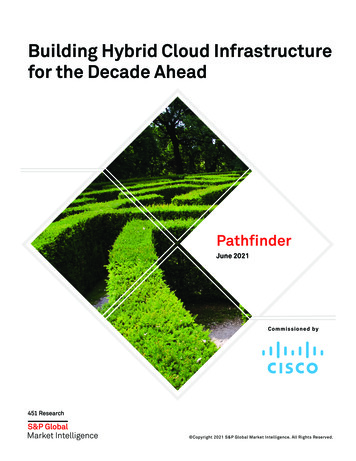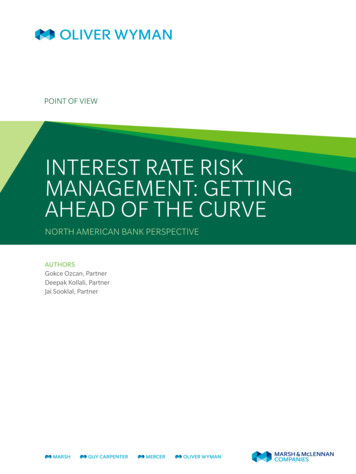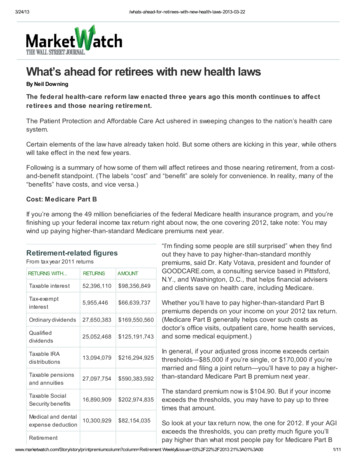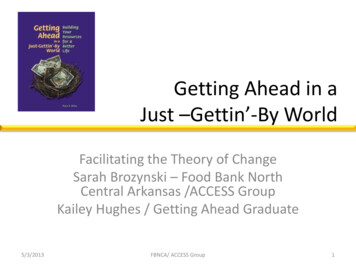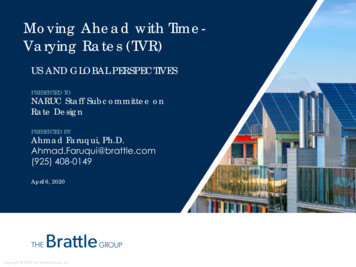
Transcription
Moving Ahead with TimeVarying Rates (TVR)US AND GLOBAL PERSPECTIVESPRESENTED TONARUC Staff Subcommittee onRate DesignPRESENTED BYAhmad Faruqui, Ph.D.Ahmad.Faruqui@brattle.com(925) 408-0149April 6, 2020Copyright 2019 The Brattle Group, Inc.
TVRs are deployed to residentialcustomers around the worldType of RateApplicabilityParticipating CustomersOklahoma (OGE)Variable Peak Pricing (VPP)Opt-in20% (130,000)Maryland (BGE, Pepco, Delmarva)Peak Time Rebate (PTR)Default80%Ontario, CanadaTime-of-Use (TOU)Default90% (3.6 million)Great BritainTime-of-Use (TOU)Opt-in13% (3.5 million)Hong Kong (CLP Power Limited)Peak Time Rebate (PTR)Opt-in27,000Arizona (APS, SRP)Time-of-Use (TOU)Opt-inAPS: 57%, SRP: 36%California (PG&E, SCE, SDG&E)Time-of-Use (TOU)Default (2020)TBD – 75-90%*California (SMUD)Time-of-Use (TOU)Default75-90%*Colorado (Fort Collins)Time-of-Use (TOU)Mandatory100%Illinois (ComEd, Ameren IL)Real Time Pricing (RTP)Opt-in50,000Michigan (Consumers Energy)Time-of-Use (TOU)Default (2020)TBD – 75-90%*FranceTime-of-Use (TOU)Opt-in50%SpainReal Time Pricing (RTP)Default40%ItalyTime-of-Use (TOU)Default75-90%**Estimated participation based on historical trendsbrattle.com 2
But there is tremendous room forgrowthThe deployment of Advanced Metering Infrastructure (AMI) is creating anopportunity to enhance customer engagement by deploying TVRs and harnessthe load flexibility benefits created by these rates––As of 2018, almost 87 million smart meters had been deployed to more than 60% ofU.S. homes (*)Smart meter penetration is expected to increase to 81% of North American homes by2024 (**)In the US, TVRs are only deployed to 6.5% of U.S. customers so there is a hugeopportunity for expansionBy comparison, in Ontario, Canada, TVRs are deployed to all residential andsmall commercial and industrial customers and 90% are taking service on TVRsNotes:(*) EIA, “Nearly half of all U.S. electricity customers have smart meters,” December 6, 2017, https://www.eia.gov/todayinenergy/detail.php?id 34012.(**) Smart Energy, “Smart meter penetration in North America will reach 81% by 2024,” July 5, 2019, will-reach-81-by-2024/brattle.com 3
There is compelling evidence from 300 pilots throughout the globe that customersrespond to TVRsPilots feature a combination of rate designs (TOU, CPP, PTR, andVPP), which influence the level of peak reduction70%Time-of-UsePeak Reduction60%Time-of-Usew/TechPeak Time Peak TimeRebateRebatew/ TechCritical PeakPricingCritical PeakVPPVPPPricingw/ Techw/ Tech50%40%30%20%10%0%Pricing TreatmentSource: The Brattle Group. Peak reductions represent results from 349 pricing treatments collected in the Arcturus 2.0 database.brattle.com 4
The magnitude of demand response variesby the peak to off-peak price ratioOn average, residential customers reduce their on-peak usage by 6.5% forevery 10% increase in the peak-to-off-peak price ratioIn the presence of enabling technology such as smart thermostats, the effect isstronger–On average, customers enrolled on TVRs that offer enabling technologies reducepeak usage by 11% for every 10% increase in the price ratioSource: Ahmad Faruqui , Sanem Sergici, and Cody Warner, “Arcturus 2.0: International Evidenceon Time-Varying Rates,” The Electricity Journal, 2017.brattle.com 5
US BenchmarkOverview of TVR OfferingsAccording to 2018 EIA Form-861, 322 U.S. utilities offer at least oneform of time-varying rate to residential customers– 303 offer Time-of-Use (TOU)– 29 offer Critical Peak Pricing (CPP)– 14 offer Peak Time Rebate (PTR)– 9 offer Variable Peak Pricing (VPP)– 6 offer Real-Time Pricing (RTP)Altogether, 5.5 million customers (or 4% of all residential customers)are enrolled on one of these time-varying ratesbrattle.com 6
US BenchmarkLargest Time-Varying DeploymentsThe following 15 utilities accounted for 86% of all customers enrolledon a time-varying rate1,200,000Customers on Time-Varying com 7
ArizonaTime-of-Use Rates (1/2)Arizona Public Service (APS) leads all U.S. utilities with the largestnumber of customers enrolled on an opt-in time-of-use rate– Over 600,000 customers, or approximately 56% of its 1.1 million residentialcustomers, are on a TOU rateAPS offers five residential rate schedules, of which three are time-ofuse rates– Saver Choice (“R-TOU-E”) includes seasonal on-peak and off-peak energycharges, with a ratio of slightly over 2:1 and an on-peak period of 3-8 PMMonday-Friday. There is also a winter-only super off-peak energy charge– The Saver Choice Plus (“R-2”) and Saver Choice Max (“R-3”) rates have asmaller peak/off-peak ratio and no super off-peak period, but include ademand charge– The other two non-TOU rates are restricted to customers with an averageusage of less than 1,000 kWhReferences:APS, Service Plans, l/Rates-Schedules-and-Adjustorsbrattle.com 8
ArizonaTime-of-Use Rates (2/2)Salt River Project, Arizona’s second largest utility, also offers threeTOU options–––Roughly 315,000 customers, or 33% of its nearly 1 million residential customers,are enrolled on a TOU rateThe SRP Time-of-Use Price Plan (“E-26”) defines on-peak hours of weekdays 2-8PM in summer and 5-9 AM and 5-9 PM in winter, with a peak/off-peak ratio of1.4:1 in winter and 2.9:1 in summerSRP’s Price Plan for Residential Super Peak Time-of-Use service offers twooptions, E-21 and E-22, both of which charge higher costs in a three hour weekday time frame The E-21 plan defines an on-peak period of weekdays 3-6 PM, while the E-22 plan’speak period covers weekdays 4-6 PM Both options have an peak/off-peak ratio of 3.5:1 in the summer, 4:1 in the summerpeak, and 1.4:1 in the winter Customers receive a 90-day bill protection. If their first three bills are higher than theywould have been on the default Basic price plan, they are credited the difference andswitched back to the Basic planReferences:SRP, Time-of-Use Price Plan, https://www.srpnet.com/prices/home/tou.aspxSRP, EZ-3 Price Plan, .com 9
CaliforniaTime-of-Use Rates (1/3)Pacific Gas & Electric (PG&E) currently has 400,000 customers on anopt-in time-varying rate––Currently, customers can opt into an E-TOU-B option with peak hours fromweekdays 4-9 PM, capped at 225,000 customersElectric vehicle owners can sign up for rate schedule EV-B, a residential time-ofuse service that requires the installation of a separate meter. EV-B chargeslowest costs in the 11 PM – 7 AM off-peak period, and higher costs in the peak(2-9 PM) and partial-peak (7 AM-2 PM and 9-11 PM) periods Some customers are on an EV-A option that combines the vehicle’s electricity costs withthose of the customer’s residence, but this rate is now closed to new enrollmentsThe other two California investor-owned utilities, Southern CaliforniaEdison (SCE) and San Diego Gas & Electric (SDG&E), haveapproximately 370,000 and 155,000 customers on opt-in TOU ratesrespectively–Almost 99% of customers that were moved to either SCE or SDG&E’s TOU pilotschose to stay on a TOU planReferences: PG&E, Tariffs, https://www.pge.com/tariffs/index.pagebrattle.com 10
CaliforniaTime-of-Use Rates (2/3)All three California investor-owned-utilities are planning thedeployment of default time-of-use rates– SDG&E is beginning its rollout in March 2020, offering two TOU plans witha 4-9 PM peak period and a 2.1:1 peak/off-peak period, as well as anadditional super off-peak period from 12-6 AM– PG&E and SCE will transition customers in October 2020The CPUC has ordered two customer guarantees as part of therollout– Customerswill be provide an estimate of how their TOU bill compareswith what their bill would have been on their old rate so they can see ifthey saved money or not– A 12-month bill guarantee, such that customers whose first-year bill underthe new TOU rate is higher than it would have been under their old ratewill be credited the differenceReferences:Utility Dive, California utilities prep nation’s biggest time-of-use rate rollout, 543402/brattle.com 11
CaliforniaTime-of-Use Rates (3/3)Sacramento Municipal Utility District (SMUD), one of the largest U.S.municipalities, already transitioned in 2019 to default TOU rates for its 600,000residential customers–The TOU rate has a peak period of 5-8 PM year-round –Summer rates, which are higher than in non-summer, feature a peak rate of 0.2941/kWh, anoff-peak rate of 0.1209, and an additional mid-peak rate (for noon-5 PM and 8 PM-midnight) of 0.1671/kWhCustomers without rooftop solar can opt out and elect the Fixed Rate, which chargesthree different flat volumetric prices based on three different periods of the year SMUD estimates the Fixed Rate is approximately 4% higher than the TOU rateBefore filing for TOU, SMUD conducted a successful pilot program in 2012 and2013 testing TOU, CPP, and TOU/CPP rates–The pilot found significant load shifting, customer preference for TOU over CPP, and 50% higher average reductions with opt-in versus opt-out (which had 90% retention)References:SMUD, Time-of-Day Rates, ay-rates/Time-of-Day-5-8pm-RateSMUD, SmartPricing Options Final Evaluation, m 12
MichiganTime-of-Use RatesIn the summer of 2019, Consumers Energy rolled out a TOU “SummerPeak Rate” to approximately 3% of its 1.6 million customers, selectingcommunities that were representative of its service territory– FromJune-September, the Summer Peak Rates charges a on-peak ratefrom weekdays 2-7 PM that is about 1.5 times higher than the off-peak rate– The off-peak rate is the regular rate from October-MayOn June 1, 2020, all residential customers will be defaulted to theTOU plan– The rollout is part of Consumers’ “Clean Energy Plan”, which commits to90% clean energy by 2040– As part of the default TOU rollout, Consumers will deploy a bill impact toolin March 2020 so customers can see how their bill would differ under thenew rateReferences:Consumers Energy, Summer Peak Rate, brattle.com 13
MarylandPeak Time Rebate ProgramsBaltimore Gas & Electric (BGE), Potomac Electric Power Co (Pepco), andDelmarva Power offer opt-out peak-time rebate programs that rewardcustomers with 1.25/kWh bill credits for reducing energy usage during ahandful of summer peak demand events––Customers receive an alert, usually the day before the savings event, and can choosewhether or not to participate in a particular event by reducing their useEnergy and peak demand reductions are bid directly into the PJM wholesale marketAll three utilities offer the program on an opt-out basis, resulting in theenrollment of nearly all customers with smart meters––According to EIA Form-861, 1.1 million (96%) of BGE customers, 516,000 (98%) ofPepco customers, and 175,000 (98%) of Delmarva customers are enrolledIn 2018, BGE reported a 76% participation rate among its 1.1 million eligiblecustomers, with an average bill credit of 6.30. BGE’s Energy Savings Days program iscurrently largest-scale deployment of dynamic pricing by any U.S. utilityReferences:BGE, Energy Savings Days, nergySavingsDays.aspxPepco, Peak Energy Savings Credit, /MD/AboutPeakEnergySavingsCredit.aspxDelmarva, Peak Energy Savings Credit, ges/DE/PeakEnergySavingsCredit.aspxbrattle.com 14
IllinoisPeak Time Rebate ProgramsCommonwealth Edison (ComEd) fully deployed smart meters to its 4 millioncustomers between 2013-2019, finishing three years ahead of scheduleAll customers with smart meters are eligible for the Peak Time SavingsProgram, with approximately 275,000 customers enrolled in summer 2018–––Customers earn a credit of 1 for every kWh saved relative to their expected usage,where a weather-normalized expected usage is calculated based on usage history.ComEd estimates that most customers will receive a 1- 12 bill credit for eacheventCustomers are notified on the day of the event, as early as 9 AM up to 30 minutesbefore the event. Historically, ComEd has announced between 3 to 5 events duringeach summer season, with each event lasting a few hours between 11 AM – 7 PMCustomers may not participate simultaneously in ComEd’s Central AC CyclingprogramReferences:ComEd, Peak Time Savings, /PeakTimeSavings.aspxComEd, Peak Time Savings Program Annual Report, https://www.icc.illinois.gov/docket/files.aspx?no P2012-0484&docId 290476brattle.com 15
IllinoisReal-Time Pricing (1/2)ComEd also offers its residential customers an Hourly Pricing Program–––Under ComEd’s Hourly Pricing program, prices vary hourly according to wholesalemarket prices. Customers can access online energy-management tools and viewtheir hourly usage from the prior dayIn 2018, the 30,251 Hourly Pricing participants saved an average of 10% ( 75)compared to ComEd’s standard fixed-price rateAn analysis by Citizens Utility Board and EDF found 97% of ComEd customerswould have seen lower bills on RTP without changing behavior. The averagecustomer would have saved 86.63 (13.2%) per yearRateAll CustomersAmount% of BillTop 5% of SaversAmount% of BillBottom 5% of SaversAmount% of BillAverage Annual SavingsMedian Savings 86.63 69.7813.2%12.6% 103.76 68.4231.0%28.8% 0.62 0.770.0%0.3%Total Annual Savings 29.8 m- 3.95 m- 10,121-References:ComEd, Hourly Pricing Program 2018 Annual Report, https://www.icc.illinois.gov/docket/files.aspx?no 15-0602&docId 285594“The Costs and Benefits of Real-Time Pricing,” CUB; EDF, November 14, 2017, /2017/11/20171114 FinalRealTimePricingWhitepaper.pdfbrattle.com 16
IllinoisReal-Time Pricing (2/2)Ameren offers an equivalent Power Smart Pricing Program– In 2018, 79% of the Power Smart Pricing’s 13,339 active participants sawsavings compared to what they would have paid under Ameren’s standardfixed-price rate. Customers saved an average of 8% ( 58)Both programs are mandated by Illinois’ Public Utilities Act, andoverseen by the Illinois Commerce CommissionReferences:Ameren, Power Smart Pricing 2018 Report, https://www.icc.illinois.gov/docket/files.aspx?no 11-0547&docId 285537brattle.com 17
OklahomaVariable Peak PricingOGE rolled out a dynamic pricing rate coupled with a smart thermostat to itsresidential customers a few years ago– “Smart Hours” features variable peak pricing, or four levels of peak pricing dependingon what day type it happens to be (Low, Standard, High, Critical)– There are fixed summer and winter peak hours– Prices during peak hours vary depending on system conditions, and are communicatedby 5:00 pm the previous day. Critical periods can be communicated with as little as twohours notice– The expectation is that there would be 10 Low price days, 30 Standard price days, 36High price days, and 10 Critical price days in a typical year.– Is also offered to Small GS customers whose annual demand is less than 10 kW or lessthan 400 kW with a load factor of less than 25%Some 130,000 customers out of 650,000 (20%) are on that rate today; theycontrol their thermostat setting, not OGE– Average peak load has dropped by 40%– Average bill savings amount to 20% of the customer’s billReferences:Oklahoma Gas & Electric, SmartHours, rthours/faq/brattle.com 18
New YorkTime-of-Use RatesConsolidated Edison (Con Edison), which serves 3.4 million customers in NewYork City’s five boroughs and Westchester County, employs a standardResidential delivery rate consisting of a fixed charge and a variable charge–For June through September, the variable charge is a two-tiered inclining block rate,while it is a flat volumetric charge in all other monthsCon Edison also offers a voluntary TOU rate with a peak period of 8 AM tomidnight–The TOU rate’s delivery rates reflect a 14.2:1 peak/off-peak ratio from June throughSeptember and a 5.2:1 ratio in all other months –The rate also has a year-round monthly customer charge of 20.46Summer super-peak pricing is in effect 2-6 PM on weekdays, but does not apply tocustomers who purchase their electricity from energy service companiesReferences:Con Edison, Current Electricity Tariffs, https://www.coned.com/ ff.pdfCon Edison, Time-of-Use Rates, programs/time-of-usebrattle.com 19
New YorkTime-Varying Demand ChargesCon Edison is also conducting a three-year Smart Energy Plan pilot programwith time-varying demand charges for distribution service–––During the peak period (noon to 8 PM weekdays), the demand charge is 19.66/kWin the summer and 15.13/kW in the winter, compared to 7.64/kW in the yearround off-peak periodAround 15,000 customers were initially recruited into the program, using both opt-inand opt-out enrollment, with the option to opt out of the program at any time Con Edison’s AMI rollout is ongoing and expected to be completed by the end of 2022.Pilot participants were selected from regions with high AMI penetration. Customers that have smart meters but were not recruited for the pilot can currentlystill enroll on a “walk-in” basisCon Edison is also testing another demand rate with a peak period of 2-10 PMweekdays and a slight difference in pricesReferences:Con Edison, Introducing the Smart Energy Plan, ergy-planCon Edison, Innovative Pricing Pilot Filing, https://www.coned.com/ -pricingpilot-filing.pdfbrattle.com 20
Lessons earned from TVR deployments(1/2)Utilities have long deployed time-varying rates, some more successfully than others.Following are key lessons learned during the past two decades of deployment12Designingthe ratesMarketingthe rates Rates should be cost-reflective to promote economic efficiency and equity. However,they should also be customer focused Unless new rates have savings opportunities, customers will either not join or notalter their usage habits to respond. Savings opportunities can be maximized bydiscounting off-peak prices substantially compared to the existing rate Most utilities offer time-varying rates but only a handful of customers are on them.Often, customers don’t even know the rates exist due to limited customer outreachand advertising on traditional and social media Customers who know the rates exist have questions, but customer service staff areuntrained to answer them while information on websites is poorly presented andcouched in utility-speak that eludes customers This can be remedied by studying customer service practices of utilities like APS andOGE, which have large numbers of customers on time-varying rates Utilities can also conduct focus groups with customers to get insights on which designfeatures appeal to customers and which ones turn them off. For further insights,conjoint analysis can be carried out with data gathered via online customer surveysbrattle.com 21
Lessons learned from TVRdeployments (2/2)345Inclusion ofenablingtechnologiesInclusion ofbehavioralmessagingTransitioningto new rates Customer responses to time-varying rates can be facilitated and often magnified byincluding new digital thermostats rapidly being acquired by customers. For example,OGE has successfully used smart thermostats to boost response and take the pain outo
Saver Choice (“R-TOU-E”) includes seasonal on -peak and off-peak energy charges, with a ratio of slightly over 2:1 and an on-peak period of 3-8 PM Monday-Friday. There is also a wi
